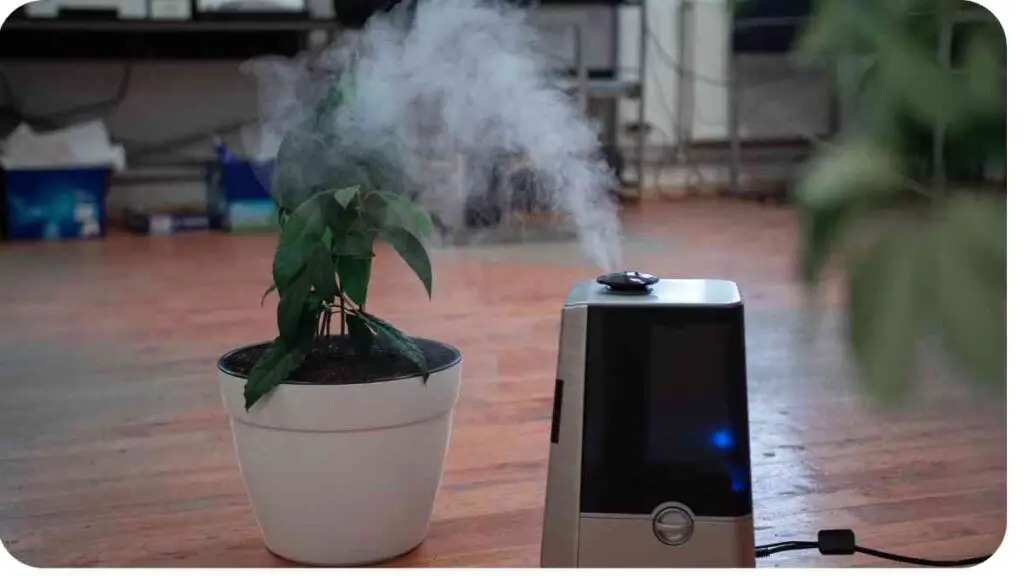Cigarette smoke doesn’t just harm humans; it can negatively impact your indoor plants as well. Think about it, cigarette smoke contains over 4,000 harmful chemicals. When these substances settle on your beloved plants, they could suffocate leaves, stunt growth, or even kill them over time.
So, if you’re a plant lover and someone who enjoys a smoke indoors, you might wonder: is cigarette smoke bad for indoor plants?
You bet it is! In this article, we’ll dive into the science behind how cigarette smoke affects your indoor greenery, what signs of damage to look out for, and how to protect your plants. Plus, I’ll share some personal experiences (spoiler: my spider plant did not like the smoke!) and tips to keep your leafy friends thriving.
| Key Takeaways |
|---|
| Cigarette smoke can harm indoor plants by reducing photosynthesis and growth. |
| Sensitive plants, like flowering varieties, are more affected than hardy plants. |
| Smoke clogs plant pores, leading to brown spots, leaf damage, and wilting. |
| Regularly cleaning plant leaves helps reduce smoke residue buildup. |
| Increasing humidity and using air purifiers can minimize the impact of smoke. |
| Artificial plants are a smoke-resistant alternative but still require cleaning. |
2. What is in Cigarette Smoke?

2.1 Chemicals Present in Cigarette Smoke
Cigarette smoke contains an alarming cocktail of toxins, including nicotine, carbon monoxide, tar, formaldehyde, and heavy metals. These are not just dangerous for humans but can wreak havoc on your plants. The delicate leaves and roots absorb these harmful substances, leading to a host of health problems for your indoor garden.
2.2 How These Chemicals Impact Air Quality
When you smoke indoors, these chemicals linger in the air, stick to surfaces, and get absorbed by anything around including plants. The air quality takes a hit, and your plants are left to deal with it. Over time, the buildup of harmful particles can clog the pores (called stomata) on plant leaves, making it harder for them to “breathe.”
3. Can Indoor Plants Absorb Cigarette Smoke?
3.1 The Role of Leaves in Absorbing Air Pollutants
Believe it or not, your plants are doing more than just sitting pretty! The leaves of plants act like air filters, absorbing harmful pollutants through their stomata. While they can absorb certain toxins and purify the air, cigarette smoke puts them under immense stress. The smoke can block their stomata, hindering their ability to perform photosynthesis effectively.
3.2 How Plant Roots Interact with Airborne Toxins
Not only do leaves suffer, but the roots also interact with the toxins. Cigarette smoke that settles on the soil can seep into the root system, further damaging the plant’s ability to absorb nutrients. If the roots can’t function properly, you’ll soon notice a significant decline in the plant’s overall health.
4. Symptoms of Cigarette Smoke Damage on Plants

4.1 Visible Signs on Leaves
Have you ever noticed brown spots or a yellowing of the leaves on your plants? These are common indicators of cigarette smoke damage. The leaves may also appear dry and brittle, showing signs of dehydration, even when you’ve been watering them regularly.
4.2 Changes in Plant Growth and Development
If cigarette smoke exposure continues, plants can experience stunted growth. Their vibrant green hue may fade, and new growth may be sparse or nonexistent. Over time, the plant may even shed leaves or stop flowering altogether.
4.3 Long-Term Effects on Indoor Plant Health
In the long run, cigarette smoke can significantly reduce a plant’s lifespan. The buildup of toxins in the leaves and soil makes it harder for the plant to recover, leading to premature death.
Table: Symptoms of Cigarette Smoke Damage on Indoor Plants
| Symptom | Visible on Leaves | Affects Growth | Long-term Consequence |
|---|---|---|---|
| Brown or Yellow Leaves | Yes | No | Leaf Death |
| Brittle, Dry Texture | Yes | Yes | Plant Weakening |
| Stunted Growth | No | Yes | Reduced Lifespan |
| Failure to Flower | No | Yes | Long-Term Decline |
5. Can Indoor Plants Help Purify Air Polluted by Cigarette Smoke?
5.1 Plants Known for Their Air Purifying Abilities
Yes, indoor plants can help purify the air, including air polluted by cigarette smoke, but they are not miracle workers. Some plants are better at absorbing and filtering airborne toxins than others. Plants like peace lilies, spider plants, and snake plants are well-known for their ability to remove toxins such as formaldehyde, benzene, and carbon monoxide from the air. However, their effectiveness depends on the severity of the pollution.
5.2 How Effective Are Plants in Combating Indoor Smoke?
While these plants can help, the truth is they can only do so much. Cigarette smoke produces a high volume of pollutants, and your indoor plants might not be able to absorb everything fast enough. Think of them as a small support system they aid in air purification, but you can’t rely solely on them to clear the air entirely. If you are a heavy indoor smoker, even the best air-purifying plants may struggle to keep up with the pollution levels.
Table: Best Air Purifying Plants for Indoor Spaces
| Plant Name | Pollutants Absorbed | Special Features |
|---|---|---|
| Spider Plant | Carbon monoxide, formaldehyde | Easy to care for, fast grower |
| Peace Lily | Benzene, formaldehyde, ammonia | Flowers indoors, good for low light |
| Snake Plant | Benzene, formaldehyde | Tolerates neglect, grows well in shade |
| Boston Fern | Formaldehyde | Adds humidity, best in cool locations |
| Aloe Vera | Formaldehyde | Healing properties, thrives in sunlight |
5.3 Table: Best Air Purifying Plants for Indoor Spaces
| Plant Name | Air Pollutants Absorbed | Ideal Growing Conditions |
|---|---|---|
| Peace Lily | Benzene, Formaldehyde, Ammonia | Low-light, minimal care |
| Snake Plant | Carbon Monoxide, Formaldehyde | Low water needs, indirect light |
| Spider Plant | Formaldehyde, Carbon Monoxide | Bright, indirect light, fast-growing |
| Boston Fern | Xylene, Formaldehyde | Cool temperatures, humid areas |
| Aloe Vera | Benzene, Formaldehyde | Sunny spots, moderate watering |
6. Comparing Cigarette Smoke Effects on Different Types of Plants
6.1 Sensitive Plants vs. Hardy Plants
Not all plants respond to cigarette smoke in the same way. Some are more sensitive to pollutants, while others are more resilient. For example, delicate plants like ferns and orchids tend to suffer more from smoke exposure than tougher plants like succulents or snake plants. Sensitive plants may wilt, develop brown spots, or stop growing altogether.
6.2 The Impact on Flowering Plants vs. Non-Flowering Plants
Flowering plants, especially those that bloom indoors, are particularly vulnerable to cigarette smoke. Smoke exposure can reduce their ability to produce flowers, leading to a less vibrant display. Non-flowering plants may still be affected, but their impact is often seen in the health of the leaves and the overall growth rate.
7. How to Protect Indoor Plants from Cigarette Smoke
7.1 Creating a Smoke-Free Environment
The best way to protect your indoor plants from cigarette smoke is to create a smoke-free environment. Smoking outside, using air purifiers, and keeping windows open can greatly reduce the amount of smoke that lingers around your plants. The less smoke in the air, the healthier your plants will be.
7.2 Table: Protective Measures for Indoor Plants
| Measure | Description | Effectiveness |
|---|---|---|
| Move Plants to a Smoke-Free Area | Relocate plants away from smoking zones | High |
| Use an Air Purifier | Filters out harmful toxins from the air | Moderate |
| Open Windows Regularly | Allows fresh air to circulate and dilute smoke | High |
| Wipe Down Leaves Regularly | Removes settled toxins from the leaves’ surface | Moderate |
7.3 Ventilation and Air Filtration Tips
Ensuring proper ventilation in your home is crucial if you want to keep both your plants and your lungs happy. Installing an air purifier can help to filter out some of the harmful substances in cigarette smoke. Additionally, make it a habit to wipe the leaves of your plants regularly, especially if you notice any residue from smoke.
8. Personal Experience with Indoor Plants and Cigarette Smoke
8.1 My Struggles with Keeping Plants Healthy in Polluted Spaces
I’ve been a plant lover for years, and let me tell you, I’ve had my fair share of struggles keeping them healthy in less-than-ideal conditions. One memorable incident was when a friend of mine, a smoker, stayed with me for a week.
My poor spider plant, usually a vibrant and fast grower, started showing signs of stress. The leaves turned brown at the tips, and new growth slowed down significantly. After my friend left, it took weeks for the plant to recover fully. That’s when I learned the hard way that cigarette smoke can seriously mess with your indoor jungle!
8.2 Stories from Other Indoor Plant Enthusiasts
I’m not the only one who has experienced this. I’ve talked to several other plant enthusiasts, and their stories are similar. One friend noticed that her peace lilies wouldn’t bloom when her roommate smoked indoors. Another had a succulent that seemed impervious to smoke but eventually showed signs of distress. The general consensus? Cigarette smoke and plants don’t mix.
9. Expert Opinions on Cigarette Smoke and Plant Health
9.1 Botanists’ Views on Smoke and Plants
Many botanists agree that cigarette smoke is harmful to indoor plants. Dr. Susan Taylor, a botanist with over 20 years of experience, explains that the chemicals in smoke can clog the plant’s pores and reduce its ability to carry out photosynthesis. “Indoor plants need clean air to thrive. Cigarette smoke introduces toxins that disrupt their natural processes,” says Dr. Taylor.
9.2 Studies on Airborne Chemicals and Plant Life
Several studies have been conducted to examine the effects of airborne pollutants on plant life. Research has shown that plants exposed to high levels of smoke struggle to maintain their usual functions. Over time, they may experience reduced growth, changes in leaf structure, and even a shortened lifespan.
10. Practical Tips for Minimizing Cigarette Smoke Damage to Plants

10.1 Regularly Clean Your Indoor Plants
If you or someone else in your home smokes, regularly cleaning your indoor plants is essential. Wiping down the leaves with a damp cloth helps remove any residue that may settle on the surface. This is especially important for plants with broad leaves, like peace lilies, that are more likely to accumulate dust and smoke particles.
10.2 Increase Humidity Around Your Plants
Cigarette smoke can dry out the air, which isn’t great for most indoor plants. You can combat this by increasing the humidity around your plants. Try misting them daily or placing a tray of water near the plants to evaporate and add moisture to the air. Some plants, like ferns, thrive in higher humidity and will appreciate this extra effort.
Table: Tips for Reducing Smoke Impact on Plants
| Tip | Description | Benefit |
|---|---|---|
| Wipe leaves regularly | Use a damp cloth to remove smoke residue | Promotes healthy growth |
| Use a humidifier or mist plants | Increases moisture to counteract drying effects | Prevents leaf damage |
| Relocate plants to well-ventilated areas | Ensures fresh air circulates around plants | Reduces exposure to smoke |
| Add an air purifier | Filters harmful pollutants from the air | Protects plant and human health |
10.3 Rotating Plants to Cleaner Areas
If you can’t entirely eliminate smoke indoors, consider rotating your plants between rooms. For example, you can place your plants in a smoke-free room during the day, allowing them to ‘breathe’ in cleaner air, and then move them back later when necessary. This will help reduce their exposure to constant smoke.
11. Cigarette Smoke vs. Other Air Pollutants: Which Is Worse for Plants?

11.1 Smoke vs. Cooking Fumes
Cigarette smoke isn’t the only thing that can harm your plants — cooking fumes, especially those from frying, can also affect indoor plant health. Both pollutants introduce chemicals and particles into the air, but cigarette smoke tends to linger longer and carry more harmful toxins. It’s important to note that while your kitchen might be ventilated, cigarette smoke in a confined room has fewer exit points.
11.2 Smoke vs. Dust and Mold
Other indoor pollutants like dust and mold are common issues, but their impact on plants is less severe compared to cigarette smoke. Dust can block sunlight from reaching your plant’s leaves, but it’s easier to clean than dealing with smoke residue. Mold, especially if it spreads to your plants’ soil, can be more harmful than smoke, but it is often a sign of excessive moisture rather than pollution.
12. Do Artificial Plants React to Cigarette Smoke?
12.1 Smoke on Artificial Plants
While real plants can suffer from cigarette smoke, artificial plants won’t wilt or experience damage. However, smoke particles can still cling to their surfaces, leading to unpleasant odors and a layer of grime that diminishes their visual appeal. Cleaning artificial plants regularly will keep them looking fresh and prevent smoke buildup.
12.2 Why Choose Artificial Plants for Smoky Environments?
If you love the look of greenery but are a smoker or live with one, artificial plants might be a smart alternative. They provide the aesthetic benefits of real plants without the same sensitivity to pollutants. Plus, they require less maintenance overall, making them ideal for people with busy lifestyles or those concerned about smoke damage.
13. Final Thoughts: Is Cigarette Smoke Bad for Indoor Plants?
The simple answer is yes cigarette smoke is bad for indoor plants. Over time, it can inhibit their growth, reduce their ability to clean the air, and even lead to premature death. While some plants are more resilient than others, none are completely immune to the harmful effects of smoke. By creating a smoke-free environment, using air purifiers, and regularly cleaning your plants, you can minimize the damage and keep your indoor jungle healthy.
Table: Summary of Cigarette Smoke Effects on Indoor Plants
| Effect | Description | Impact Level |
|---|---|---|
| Reduced Photosynthesis | Smoke clogs pores, reducing sunlight absorption | High |
| Slowed Growth | Toxins inhibit plant growth and new leaf formation | Moderate to High |
| Increased Leaf Damage | Brown spots, wilting, and tip burn | Moderate |
| Shortened Lifespan | Prolonged exposure leads to plant death | High |
Further Reading
If you’d like to learn more about the impact of cigarette smoke on indoor plants, here are some helpful resources:
- Does Cigarette Smoke Affect Plants?
Gardening Know How explains how cigarette smoke can harm plants and what steps can be taken to minimize damage. - Effects of Tobacco Smoke on Growing Plants
The University of Washington provides insights into how tobacco smoke affects both outdoor and indoor plants, with a focus on scientific research. - Can Smoke from Wildfires and Cigarettes Harm Plants?
This blog from the University of California examines the broader impact of smoke, including cigarette and wildfire smoke, on plant health.
FAQs
Does cigarette smoke harm all types of indoor plants?
Yes, cigarette smoke can harm most indoor plants, but some species, like succulents, are more resilient compared to sensitive flowering plants.
How does cigarette smoke affect photosynthesis in plants?
Cigarette smoke can clog the pores (stomata) on plant leaves, reducing their ability to absorb sunlight and perform photosynthesis effectively.
Can air purifiers help protect plants from cigarette smoke?
Yes, air purifiers can filter out smoke particles and harmful chemicals, making the indoor environment safer for your plants.
Is it better to keep plants away from smokers?
Yes, moving plants to a well-ventilated or smoke-free room can reduce their exposure to harmful toxins from cigarette smoke.
Do artificial plants get damaged by cigarette smoke?
Artificial plants don’t suffer from cigarette smoke damage like real plants, but they can accumulate smoke residue, requiring regular cleaning to maintain their appearance.

For 15 years, Hellen James has worked in the gardening industry as an expert and landscape designer. During her career, she has worked for a variety of businesses that specialize in landscaping and gardening from small firms to large corporations.

